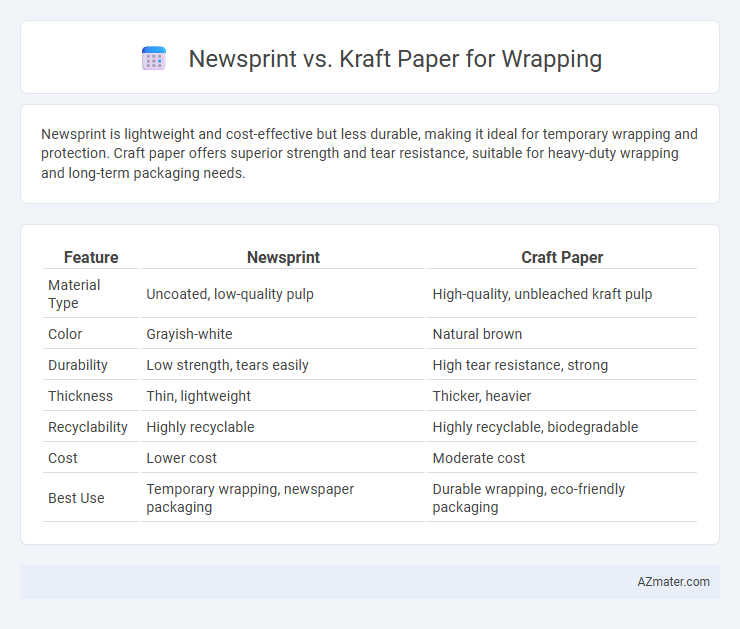Newsprint is lightweight and cost-effective but less durable, making it ideal for temporary wrapping and protection. Craft paper offers superior strength and tear resistance, suitable for heavy-duty wrapping and long-term packaging needs.
Table of Comparison
| Feature | Newsprint | Craft Paper |
|---|---|---|
| Material Type | Uncoated, low-quality pulp | High-quality, unbleached kraft pulp |
| Color | Grayish-white | Natural brown |
| Durability | Low strength, tears easily | High tear resistance, strong |
| Thickness | Thin, lightweight | Thicker, heavier |
| Recyclability | Highly recyclable | Highly recyclable, biodegradable |
| Cost | Lower cost | Moderate cost |
| Best Use | Temporary wrapping, newspaper packaging | Durable wrapping, eco-friendly packaging |
Introduction to Newsprint and Craft Paper
Newsprint is a lightweight, uncoated paper primarily made from recycled wood pulp, widely used for newspapers and packaging due to its affordability and eco-friendly properties. Craft paper, also known as kraft paper, is a durable, brown paper made from chemical pulp, prized for its strength and versatility in wrapping and packaging applications. Both papers offer distinct benefits: newsprint excels in cost-effectiveness and recyclability, while craft paper provides superior durability and tear resistance.
Key Differences Between Newsprint and Craft Paper
Newsprint is a lightweight, inexpensive paper made from recycled wood pulp, ideal for temporary wrapping and protection due to its low durability and ink absorption properties. Craft paper, typically thicker and more durable, is produced from virgin or recycled fibers and offers superior strength and tear resistance, making it suitable for packaging and long-term wrapping needs. The key differences lie in their texture, strength, and intended use, with newsprint suited for short-term tasks and craft paper preferred for sturdier, eco-friendly packaging solutions.
Material Composition and Manufacturing Process
Newsprint is primarily made from recycled wood pulp with high lignin content, resulting in a lightweight, low-cost paper ideal for short-term use. Craft paper, often produced from virgin or recycled kraft pulp, undergoes a chemical pulping process that removes lignin, creating a stronger, more durable material suitable for heavy-duty wrapping. The manufacturing of craft paper emphasizes tensile strength and tear resistance, while newsprint prioritizes cost efficiency and print quality.
Strength and Durability Comparison
Newsprint paper is lightweight and offers moderate strength, making it suitable for light wrapping tasks but prone to tearing under stress. Craft paper features a denser fiber composition and higher tensile strength, providing superior durability and better resistance to punctures and abrasions. For packaging requiring enhanced protection and durability, craft paper is the preferred choice due to its robust structure and long-lasting performance.
Environmental Impact and Sustainability
Newsprint is made from recycled wood pulp, offering a lower carbon footprint and reduced deforestation compared to virgin fiber craft paper. Craft paper, often derived from unbleached virgin fibers, provides durability but may contribute to higher environmental impact due to resource-intensive production. Choosing newsprint for wrapping supports circular economy goals by promoting recycling and minimizing landfill waste.
Cost Analysis: Newsprint vs Craft Paper
Newsprint generally costs significantly less than craft paper, making it a budget-friendly option for bulk wrapping needs. Craft paper offers better durability and a more polished appearance but comes with a higher price, reflecting its quality and versatility. Businesses prioritizing cost-efficiency often choose newsprint for large-scale packaging, while those valuing presentation may invest in craft paper despite the added expense.
Wrapping Efficiency and Ease of Use
Newsprint offers excellent wrapping efficiency due to its lightweight nature and flexibility, allowing easy molding around irregular shapes, making it ideal for bulk packaging and quick wrapping tasks. Craft paper, though slightly heavier and thicker, provides superior durability and tear resistance, enhancing protection during transport and repeated handling. Both materials are easy to use, but craft paper's sturdier texture allows for cleaner folds and better adhesive application, improving overall wrapping quality.
Printability and Customization Options
Newsprint offers moderate printability with a tendency for ink to bleed due to its porous fibers, making it suitable for simple, low-cost printing jobs. Craft paper excels in printability, delivering sharp, vibrant images and text because of its smoother surface and higher durability. Customization options are broader with craft paper, allowing for various finishes, coatings, and embossing techniques, whereas newsprint is mostly limited to basic printing and minimal customization.
Ideal Use Cases for Newsprint and Craft Paper
Newsprint excels for lightweight, short-term wrapping needs such as packaging newspapers, protecting fragile items during shipping, or creating disposable coverings for food trays due to its affordability and high printability. Craft paper offers superior strength and durability, making it ideal for heavy-duty wrapping tasks like securing gifts, wrapping boxes for retail, or eco-friendly packaging that requires a natural, rustic appearance. Selecting newsprint suits budget-conscious, low-impact applications, while craft paper fits scenarios demanding enhanced protection and aesthetic appeal.
Choosing the Right Paper for Your Wrapping Needs
Newsprint offers an affordable and lightweight option suitable for everyday wrapping needs, providing good coverage but limited durability. Craft paper boasts higher strength and a natural, rustic appearance, making it ideal for wrapping fragile items or gifts requiring more protection. Selecting the right paper depends on factors like budget, desired aesthetic, and the level of protection needed for the contents.

Infographic: Newsprint vs Craft Paper for Wrapping
 azmater.com
azmater.com